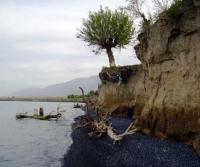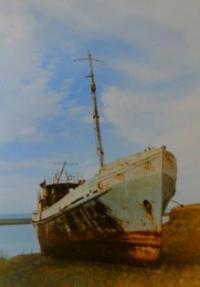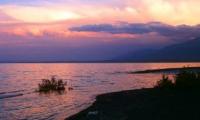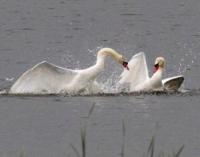Вы здесь
Alakol Lake. Kazakhstan.







Tours to Lake Alakol.
"And only from a distance the gracious
Burun, who believed in the darkness,
Rise, violent, crazy
On a glossy rock”
Nikolai Gumilev. "On the sea".
Rest on Kazakhstan lakes.
Alakol is a salt-free drainage lake located on the Balkhash-Alakol lowland, which is located on the border of the Almaty and East Kazakhstan regions, in the eastern part of the Balkhash-Alakol depression at an altitude of 374 meters above sea level.
In the period from the XIIth to the XIXth centuries, it had several names: Turge-Nor (from the Mongolian "bridge-lake"), Alaktagol, Alateniz, Alakta. More than 15 tributaries flow into the lake, of which the main rivers are the Urzhar, Katynsu, Emelkuys, Irgayty, Zhamanta, Zhamanotkol, Tasty rivers.
Together with the lakes Sasykkol, Uyaly, Zhalanashkol and others, more small, forms the Alakol lake system. The maximum depth, equal to 54 m, is recorded southwest of the island of Kishkene-Araltobe. On average, the depth does not exceed 24 m. In the Kishi-Alakol Bay the greatest depth is 16.5 m.
The lake water contains a significant amount of salts - from 1100 to 10000 mg/l. The ice regime of the Alakol depression is not the same. Ledostat is established first on Lake Uyaly (in the first decade of December) and later than all - on Lake Alakol (in the third decade of December).
The maximum ice thickness is 80-100 cm. The lake Jalanashkol is cleared of ice first (at the end of March), and the last is Alakol (at the end of April - beginning of May). The lake is located in the Alakol basin between Tarbagatai and Dzhungarsky Alatau. Forms the Alakol lake system.
The area of about 2200 - 2650 square kilometers, the volume of water is 58.5 billion cubic meters, the length of the coastline is 384 km, the area of the entire Alakol lake system is 48 thousand km2. The average long-term water temperature is from 4.5 to 15.3 ºС (May -November), maximum in September.
Wind speed above the lake is from 2 to 60 m / s. In the autumn-winter period. The highest wave height is 2 - 2.5 meters. The duration of freezing up is about 2 months (F ebruary - March). The largest ice thickness is 0.8 m (in February). Melting ice in April, early May.
More than 15 tributaries flow into Alakol, the main rivers Urzhar, Emel, Katinsu, Irgayty, Zhamanta, Zhamanotkol, Tasty and others. The highest water levels were noted in 1908 and 1974, the lowest in 1946. From 1947 to 1974, the lake level increased by 7.18 meters, the area increased by 600 sq. Km, and the volume of water by 17 km, cubic meters.
Since 1975, a decrease in water level has been observed. The coast is heavily indented by numerous peninsulas, capes, bays, and bays. The bays of Bolshoi and Maly Balgyn are quite deep and are used as refuge ports. In the center of Alakol there are islands: Ulken, Kishken Araltobe, Belkuduk, etc.
The climate of the coast is sharply continental. A difficult wind regime is noted above the lake. The maximum wind speed over the northern parts of the lake reaches 40-50 m / s, over the southeastern and central 50 - 60 m / s.
The most active winds in the autumn-winter period, when the wave height can be up to 2 - 2.5 m. The duration of the freeze-up was about 2 months (February-March). The largest ice thickness is 0.8 m (in February). Melting ice - April - the beginning of May.
The water temperature at the end of May reaches +7, +15 degrees Celsius. Mineralization of water in the water ranges from 1.2 to 11.6 g / l. The composition of the water is sodium chloride and chloride-sulfate-sodium. In the waters of Lake Alakol there is an increased content of fluorine and bromine.
Phytoplankton is represented by 58 species of algae. Along the lake, common reed, sedge, reedweed, reeds, cattail, soft aquatic vegetation, arrowhead leaves, ditty, urut, hornwort, etc. grow up to 80 species in the composition of zooplankton. Eight species of fish live in the waters of Alakol.
Commercial are pike perch, common carp, marinka, perch. At the mouths of the rivers flowing into the lake there is a muskrat. Cormorants, jackdaws, loons, swans, pelicans, herons, ducks live on the coast. A spotted cat, a water rat, are found in reed beds.
Part of the territory of the lake (20 thousand hectares) is protected. It is known that many years ago the famous Great Silk Road passed by water “bowls” called Alakol. Already in those days, caravans, unable to refuse, after a tiring journey, refreshment in the waters of the lake, noticed: salty waves miraculously restore strength and strengthen health.
By themselves, skin scuffs on the legs disappeared from people, wounds on the body quickly healed, those suffering from radiculitis forgot about back pain, even quarrels and resentments moved away to the side.
Modern medical research confirms the healing qualities of lake water. Alakol’s sea breath in combination with the dry, hot, drunken aroma of the steppes air favorably affects the environment. And yet, as noted by archaeologists, this unique place on the map of East Kazakhstan to this day remains a kind of "Silk Road" for the bird tribe.
Birds, rushing from north to south, stop to rest precisely here. This is a real paradise for birds. There are rare ones: out of almost 300 species of birds 38 are listed in the Red Book of the International Union for the Protection of Nature and Natural Resources.
For example, relict gulls, pink and curly pelicans, white herons, spoonbills, black storks, whooper swans ... In the vicinity of birds hiding in the waters of Alakol, the Red Book fish - Ili marinka. Remoteness from big cities and some severity of climate kept the lake and its fauna from visiting tourists for a long time.
Now on the beaches of Alakol in summer, as they say, the apple has nowhere to fall. The violated peculiar "ecocapsule" can bring a lot of troubles. That is why, having gained independence, Kazakhstan began to take nature conservation seriously.
In 1994, the Parliament of Kazakhstan ratified the Convention on Biological Diversity, thereby confirming its desire to preserve the unique richness of nature. The real step towards the implementation of these documents was the creation in 1998 of the Alakol State Reserve.
Concerning the origin of the name “Alakol”, the scientist Mr. Konkashbaev suggests that it comes from a combination of ancient Turkic and Mongolian words such as Alakol “great lake” or “mountain lake”. Another clue to this unusual name is the various shapes of those lakes that make up the water system of Lake Alakol.
In addition, the water in these lakes has an unusual, at first glance, color. For example, Alakol - pale and dark blue, Sasykkol - blue, Korzhynkol. - grayish, and Kylytuz - yellow. Thus, the variety of external shape, location, volume and color gave rise to locals to name Lake Alakol, where “Ala” means “different”, “diverse”.
Authority:
"Zhetysu is the Land of tourism”. A Tourist Guide-book. Almaty. 2003. 68 p.
Photos
Alexander Petrov.







